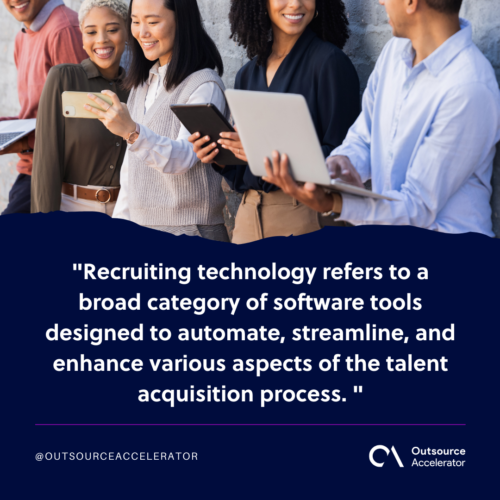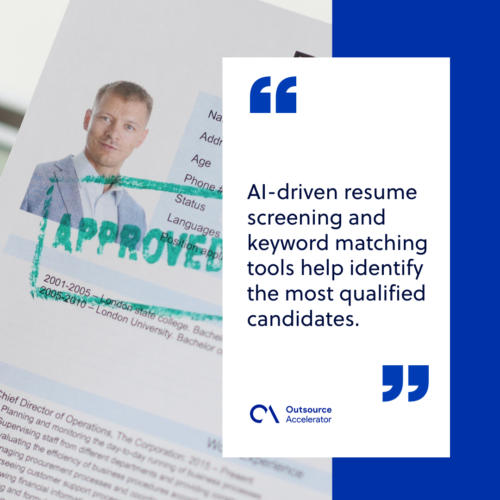How recruiting technology is changing the hiring scene

The integration of cutting-edge technology has become a game-changer when it comes to hiring people. Recruitment processes have become streamlined.
What was once characterized by manual paperwork and hours of labor-intensive effort now gives way to powerful solutions. Today’s innovations enhance the experience for both candidates and employers.
But, HR specialist Josh Bersin found that 74% of companies underperform when it comes to recruitment. For businesses, take the next step forward and introduce recruiting technology into your practices.
This article explores the aspects of recruiting technology and the benefits it brings. From AI-driven resume screening to virtual interviews, join us as we delve into these innovative hiring solutions.
What is recruiting technology?
Recruiting technology refers to a broad category of software tools designed to automate, streamline, and enhance various aspects of the talent acquisition process.
These technologies leverage digital innovations, data analytics, and AI to assist recruiters in managing candidates.
Recruiting technology is also called HR technology or talent management software.
This type of software is becoming increasingly important as businesses look for ways to make their hiring processes more efficient. This is especially true in the face of increasing competition for top talent.

Types of recruiting technology
Recruiting technology encompasses a wide range of tools and software solutions designed to upgrade various aspects of the hiring process.
Here are some types of recruiting technology that are commonly used:
Applicant Tracking Systems (ATS)
ATS software helps recruiters organize and manage job applications. It can assist with collecting applicant information, organizing them based on experience or skill sets, and tracking their progress through the hiring process.
Job boards and posting tools
Online job boards serve as platforms for organizations to post job openings, reaching a wider pool of candidates. By posting, companies can promote their vacancies and attract potential candidates.
Video interview platforms
Video interviewing tools enable remote and even asynchronous job interviews. These save both candidates and employers time and resources, especially in a new era of remote work.
These recruiting technology platforms enable recruiters to conduct interviews with candidates from anywhere. They often include features like video recording, live interviews, and candidate assessments.
Candidate relationship management (CRM) systems
This recruiting technology focuses on building and nurturing relationships with potential candidates. They’re also called talent relationship management (TRM) systems to differentiate them from sales CRMs.
They help maintain a talent pipeline and engage with candidates over time. This applies even when there are no specific job openings currently available.
Artificial intelligence (AI) and machine learning (ML)
AI and ML are being increasingly used in recruiting technology to automate tasks and improve the efficiency of the hiring process.
Some applications of AI and ML in hiring include:
- Predictive analytics to forecast future hiring needs and identify the best candidates
- Chatbots and virtual assistants to engage with interested job seekers
- Resume screening to streamline the filtering of applicants
Benefits of using recruiting technology
Here are some of the key advantages of using recruiting technology:
Efficiency and time savings
Streamlined processes, automated tasks, and centralized data management reduce the time required for each hiring stage. This allows HR teams to focus on high-value activities.
Improved candidate experience
User-friendly application portals and communication tools improve the candidate experience. This leads to higher applicant satisfaction and potentially attracting top talent.
Better candidate screening
AI-driven resume screening and keyword matching tools help identify the most qualified candidates. This reduces manual resume review and ensures a more effective screening process.

Wider talent pool
Recruiting technology expands the reach of job openings. Recruitment tools enable businesses to tap into a broader and more diverse pool of candidates.
Tips when selecting new recruiting technology
Selecting the right recruiting technology for your organization is crucial for optimizing your hiring processes and finding the best talent.
Here are some tips to consider when choosing a recruiting technology well suited for your hiring requirements:
Identify your needs
Before investing in any recruiting technology, you must clearly define your organization’s specific needs and challenges.
Consider your pain points and areas where you need the most support, such as candidate sourcing, applicant management, or interview scheduling. Doing this will help you narrow down and prioritize the functionalities you require.
Understand your budget
Determine your recruiting technology budget, including initial costs and ongoing expenses. Consider factors like subscription fees, implementation costs, and potential training expenses.
Once you’ve used the software for some time, you can evaluate the return on investment (ROI).
Conduct thorough research
There are many different recruiting technology options available in the market. Read reviews, analyze case studies, stay informed on trends, and get recommendations from industry peers or experts.
This will help you understand the capabilities associated with each solution.
Assess integration capabilities
Assess how well the new technology will integrate with your existing HR systems. You may want to explore options that work well with your current payroll software or human resource information system (HRIS).
Seamless integration can improve data accuracy and minimize manual work.
Evaluate user experience
Evaluate how the technology impacts the user experience, especially for the candidates interacting with it. It should make the application process as smooth and user-friendly as possible.
If possible, request a trial period to check if it aligns with your needs. Involve relevant teams in the feedback and decision-making process.
Check for customization and scalability
Look for recruiting technology solutions that can be customized to align with your unique recruitment processes and workflows. A one-size-fits-all solution might not satisfy your unique requirements.
Choose one that can grow with your organization. Ensure it can handle an increase in hiring needs and adapt to changing circumstances.

Consider support and training
Check what level of support and training the recruiting technology provider offers. Will they offer onboarding assistance, ongoing support, and training resources?
Having this access can help you maximize the value of the new tool.







 Independent
Independent




